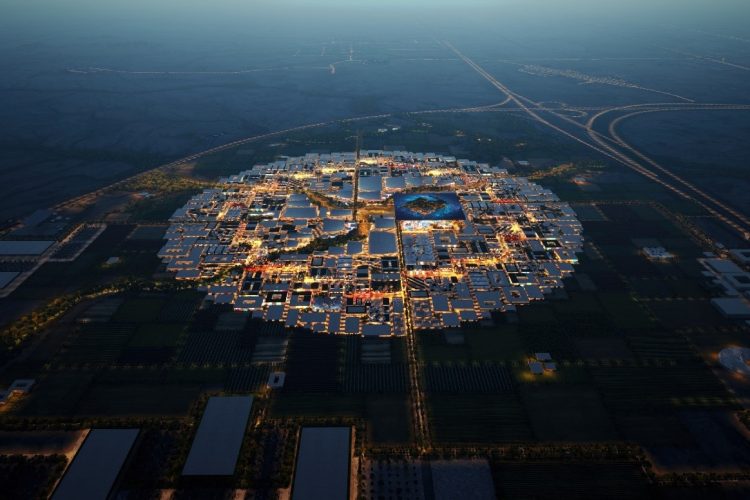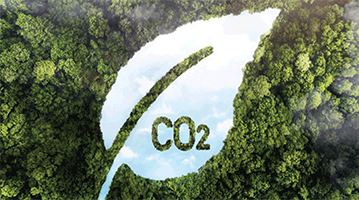
In this blog, we will explore the natural carbon cycle—how carbon moves through our planet and helps keep everything in balance. We’ll discuss the important role of greenhouse gases, which help regulate the Earth’s temperature. Before we dive deeper, just imagine what would happen if there were no greenhouse gases on Earth? Without them, the average global temperature would drop to about -18°C (0°F), making the planet too cold to support most life on earth. This blog covers
Before humans existed, the Earth was mostly carbon neutral, meaning it had a healthy balance of carbon thanks to natural processes. However, human activities like burning fossil fuels, cutting down trees, and industrialization have upset this balance, causing too much CO₂ to enter the atmosphere. This extra carbon is enhancing the greenhouse effect and contributing to climate change.
We will also look at the measures we can take to fix this problem, such as using renewable energy, planting more trees, and capturing carbon emissions. Our goal is to understand how we can work towards being carbon neutral and help restore the Earth’s natural balance.
Natural Carbon Cycle
The natural carbon cycle is the process by which carbon moves between the Earth’s atmosphere, land, oceans, and living organisms, maintaining balance in the environment. Carbon is the fourth most abundant element in the universe. With its ability to form complex molecules such as DNA and proteins, carbon makes life on Earth possible. It begins with carbon dioxide (CO₂) in the atmosphere, which is absorbed by plants during photosynthesis. Plants use sunlight and CO₂ to produce energy in the form of carbohydrates (like sugars), which they store.

The chemical equation for photosynthesis is:
6CO2 + 6H2O + sunlight → C6H12O6 (Sugars) + 6O2
When animals eat plants, they consume these carbohydrates, using them for growth and energy. During this process, animals release CO₂ back into the atmosphere through respiration. This CO₂ is a byproduct of converting the energy stored in the plants.
When plants and animals die, they decompose, and microorganisms break down their remains, releasing more CO₂ back into the atmosphere or storing some of it in the soil. In the oceans, a similar process occurs—marine organisms absorb CO₂, and when they die, their remains contribute to oceanic carbon storage
Sometimes, when plants and animals die, instead of decomposing and releasing carbon back into the atmosphere, their remains get buried deep underground. Over time, layers of soil and sediment build up on top of them and under intense pressure and heat, these buried remains are transformed into fossil fuels like coal, oil, and natural gas.
This cycle of carbon moving from the atmosphere to plants, animals, the ocean, and back into the air is continuous and keeps the Earth’s carbon levels balanced naturally. It’s a vital part of maintaining life and climate stability on Earth.
Earth’s Balance Before Human Impact
Before humans started to significantly affect the environment, the Earth maintained a natural balance of carbon. Processes like volcanic eruptions and animal breathing released carbon into the air, but plants, oceans, and soil absorbed it. Forests and oceans played an important role in storing extra carbon, which helped prevent too many greenhouse gases from building up. This balance kept Earth’s temperature steady and the climate suitable for life. The carbon cycle was in harmony, with the carbon being released and absorbed in equal amounts, keeping things stable.
Importance of Green House Gas

Greenhouse gases are gases in the Earth’s atmosphere that trap heat. They let sunlight enter the atmosphere freely but prevent some of the heat that sunlight brings from leaving the atmosphere. This trapping of heat is called the greenhouse effect, and it keeps the Earth warm enough to support life. Without greenhouse gases, our planet would be too cold for life as we know it
The process works like this: sunlight passes through the atmosphere and heats the Earth’s surface. The Earth then radiates heat back toward space, but greenhouse gases absorb some of this heat and re-radiate it back to the Earth’s surface, keeping the planet warm.
Greenhouse Gases in the Atmosphere and Where They Come From
- Carbon Dioxide (CO₂)
- Source: Burning of fossil fuels (coal, oil, natural gas), deforestation, industrial processes, and respiration.
- Key Contributors: Power plants, vehicles, industrial facilities, and agricultural practices.
- Methane (CH₄)
- Source: Decomposition of organic waste in landfills, agriculture (especially rice paddies and livestock digestion), oil and gas extraction, and coal mining.
- Key Contributors: Livestock (cows, sheep), rice cultivation, waste management, and oil/gas production.
- Nitrous Oxide (N₂O)
- Source: Agricultural activities, especially the use of synthetic fertilizers, fossil fuel combustion, wastewater management, and industrial processes.
- Key Contributors: Fertilizer application, fossil fuel burning, and certain industrial practices (such as nylon production).
- Water Vapor (H₂O)
- Source: Natural evaporation from oceans, lakes, and rivers, as well as transpiration from plants. Not significantly influenced directly by human activities, but increased by warming from other greenhouse gases.
- Key Contributors: The natural hydrological cycle, which is intensified by rising global temperatures.
- Ozone (O₃)(Tropospheric Ozone)
- Source: Created by chemical reactions between nitrogen oxides (NOx)and volatile organic compounds (VOCs) in the presence of sunlight. Ozone at ground level is a pollutant and contributes to warming.
- Key Contributors: Vehicle emissions, industrial emissions, and chemical solvents.
- Chlorofluorocarbons (CFCs) and Hydrofluorocarbons (HFCs)
- Source: Synthetic chemicals used in refrigeration, air conditioning, aerosol propellants, and foam-blowing agents. CFCs are being phased out due to their impact on the ozone layer, but HFCs are still in use as replacements.
- Key Contributors: Refrigerants, air conditioners, and aerosol products.
- Perfluorocarbons (PFCs)
- Source: Byproduct of aluminum production and semiconductor manufacturing.
- Key Contributors: Industrial processes, particularly in electronics and aluminum industries.
- Sulfur Hexafluoride (SF₆)
- Source: Used in electrical insulation, magnesium processing, and as a tracer gas in scientific research.
- Key Contributors: Electrical systems, particularly in power transmission and distribution systems.
These greenhouse gases trap heat in the atmosphere, leading to the greenhouse effect, which causes global warming and climate change. Each gas has a different Global Warming Potential (GWP), meaning some gases (like methane and nitrous oxide) are more potent at trapping heat than carbon dioxide, even if they are present in smaller quantities.
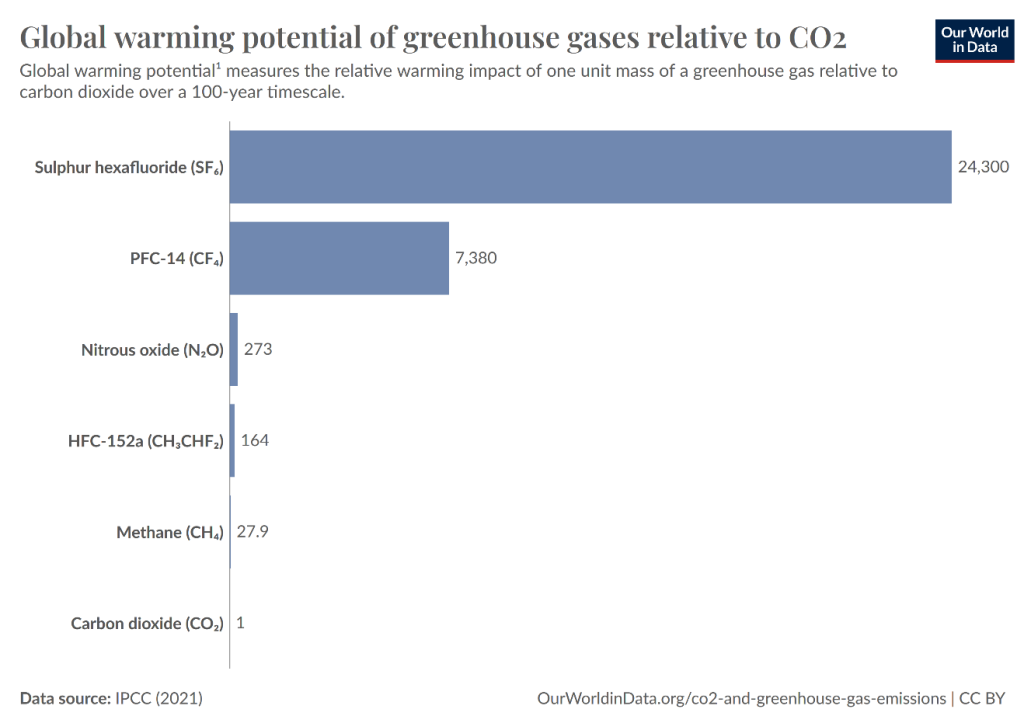
Global Warming Potential (GWP) is a measure used to compare the ability of different greenhouse gases to trap heat in the atmosphere over a specific period, usually 100 years. Carbon dioxide (CO₂) is used as the baseline with a GWP of 1, meaning all other gases are compared to CO₂’s impact. Gases with higher GWP trap more heat, contributing more significantly to global warming.
Impact of Human Activities on the Natural Carbon Cycle
After humans began to industrialize and burn fossil fuels, it disrupt the Earth’s carbon cycle, leading to global warming, melting ice caps, rising sea levels, and extreme weather events. The pre-industrial CO₂ levels were around and now it is increased to over 420 ppm, and Earth’s temperature has risen by 1.1°C since the late 19th century.
- Increased CO₂ Emissions:
- The burning of fossil fuels (coal, oil, and natural gas) for energy, transportation, Agriculture and industrial processes releases large amounts of CO₂ into the atmosphere.
- According to the Global Carbon Project, CO₂ emissions from fossil fuels and industry rose from about 6 billion metric tons in 1950to over 36 billion metric tons in 2022. This represents a sixfold increase in just over 70 years.
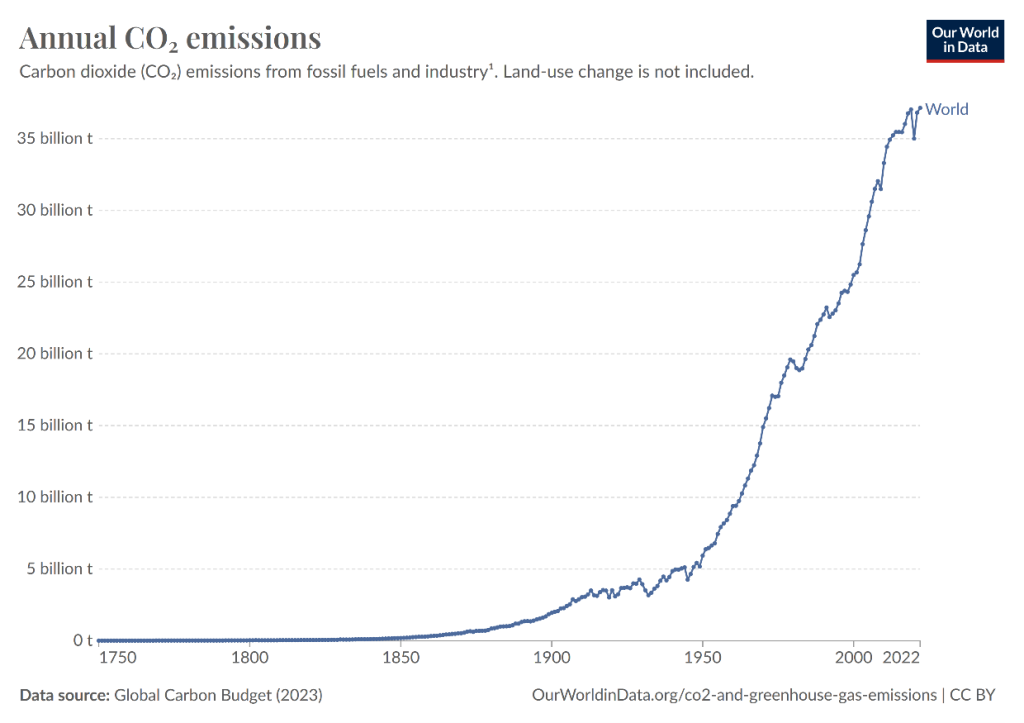
- Disruption of the Carbon Balance:
- Before industrialization, the Earth maintained a near-equilibrium in the carbon cycle, with natural processes absorbing as much CO₂ as was released.
- However, now humans are adding approximately 3 billion more metric tons of CO₂to the atmosphere each year than what natural processes can absorb.
- Deforestation has a significant impact on the carbon cycle by reducing the planet’s ability to absorb CO₂.
- Contribution of Other Greenhouse Gases:
-
- In addition to CO₂, human activities have also significantly increased the levels of other greenhouse gases, such as methane (CH₄) and nitrous oxide (N₂O).
- Methane concentrations have more than doubled since the pre-industrial era, primarily due to agriculture, landfills, and natural gas production.
- Livestock, particularly cows, produce large amounts of methane through digestion (enteric fermentation), and rice cultivation also contributes to methane emissions.
- Organic waste in landfills produces methane through decomposition, and this is a major source of methane emissions.
- Nitrous oxide levels have increased by about 20%due to agricultural practices and fossil fuel combustion.
- Feedback Loops:
- As the climate warms, feedback loops further exacerbate the problem. For example, warming temperatures can lead to increased decomposition of organic matter in soils, releasing even more CO₂ and methane into the atmosphere.
- Thawing permafrost in Arctic regions releases previously trapped methane, further contributing to the greenhouse effect.
- Ocean Absorption Capacity:
- The oceans have absorbed about 30%of the CO₂ emitted by human activities, which has led to ocean acidification, impacting marine life and disrupting carbon storage capabilities.
- However, this absorption rate is not sufficient to counterbalance the overwhelming amounts of CO₂ being released into the atmosphere.
Reversing the Impact: Achieving Carbon Neutrality
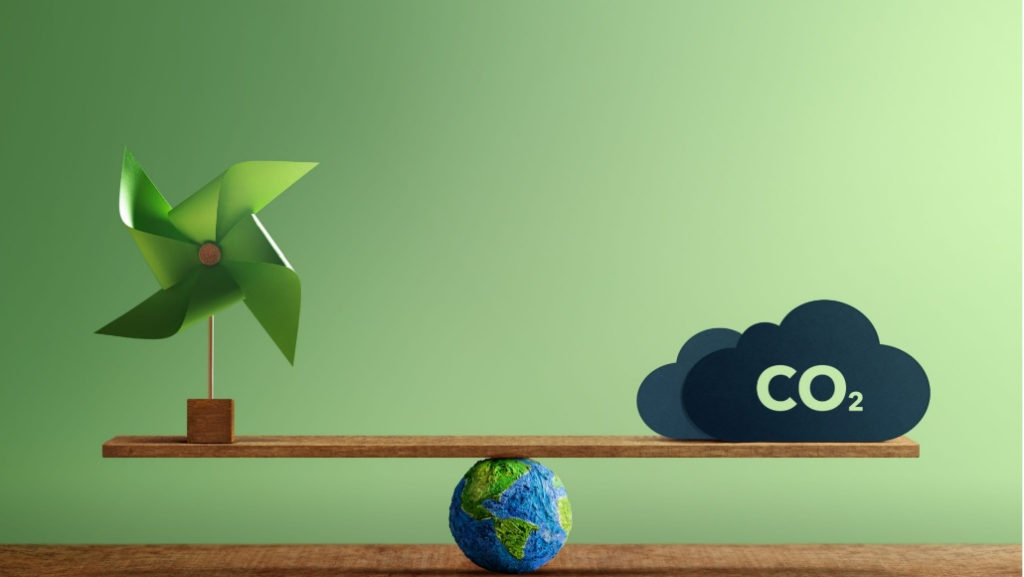
To restore balance to the natural carbon cycle, immediate actions are required across various sectors.:
- Shift to Renewable Energy: According to the International Energy Agency (IEA), replacing fossil fuels with renewable energy sources like wind, solar, and hydropower could reduce global CO₂ emissions by nearly 70% by 2050. For example, solar power already saved over 860 million metric tons of CO₂ in 2022 alone. This transition is critical, as fossil fuel combustion accounts for around 75% of global greenhouse gas emissions .
- Reforestation and Afforestation: Studies estimate that restoring forests could absorb approximately 200 gigatons of CO₂ by the end of the century. Reforestation and afforestation have the potential to sequester up to 3 billion metric tons of CO₂ annually, playing a critical role in offsetting emissions .
- Sustainable Agriculture: Agriculture contributes about 11% of global greenhouse gas emissions, primarily from methane and nitrous oxide. Practices like reducing chemical fertilizers, implementing crop rotation, and improving manure management can decrease emissions. Precision farming and regenerative practices are estimated to reduce emissions from agriculture by up to 50%, while sustainable livestock management could cut methane emissions by 30% .
- Reduce Waste: Waste contributes approximately 3-5% of global greenhouse gas emissions, mainly through methane from landfills. Reducing waste generation, increasing recycling, and improving landfill gas capture systems can lower methane emissions by up to 80%. For example, improved landfill management can capture methane emissions equivalent to about 60 million metric tons of CO₂ annually .
- Innovative Technologies: Carbon capture and storage (CCS) technologies have the potential to remove up to 10 gigatons of CO₂ per year by 2050, according to the Global CCS Institute. Bioenergy with carbon capture and storage (BECCS) could also contribute to net-negative emissions, with the potential to capture up to 5 gigatons of CO₂ annually.
Conclusion
In summary, the natural carbon cycle is essential for maintaining life on Earth. It involves the movement of carbon through various processes, primarily driven by sunlight, plants, and animals. However, human activities, especially the burning of fossil fuels and deforestation, have significantly disrupted this cycle, leading to increased levels of CO₂ in the atmosphere. By developing sustainable technologies and promoting environmental stewardship, we can work toward rebalancing the carbon cycle and ensuring a healthier planet for future generations.
“We are the first generation to feel the impact of climate change and the last generation that can do something about it.” – Barack Obama
Author
Jasline F
Jasline is a passionate sustainability professional with a Bachelor's degree in Electrical and Electronics Engineering from Anna University. With a passion for sustainable design and engineering solutions, He combines his technical expertise with his commitment to green building practices. Jasline continues to explore innovative approaches in the field of energy efficiency and sustainability.

